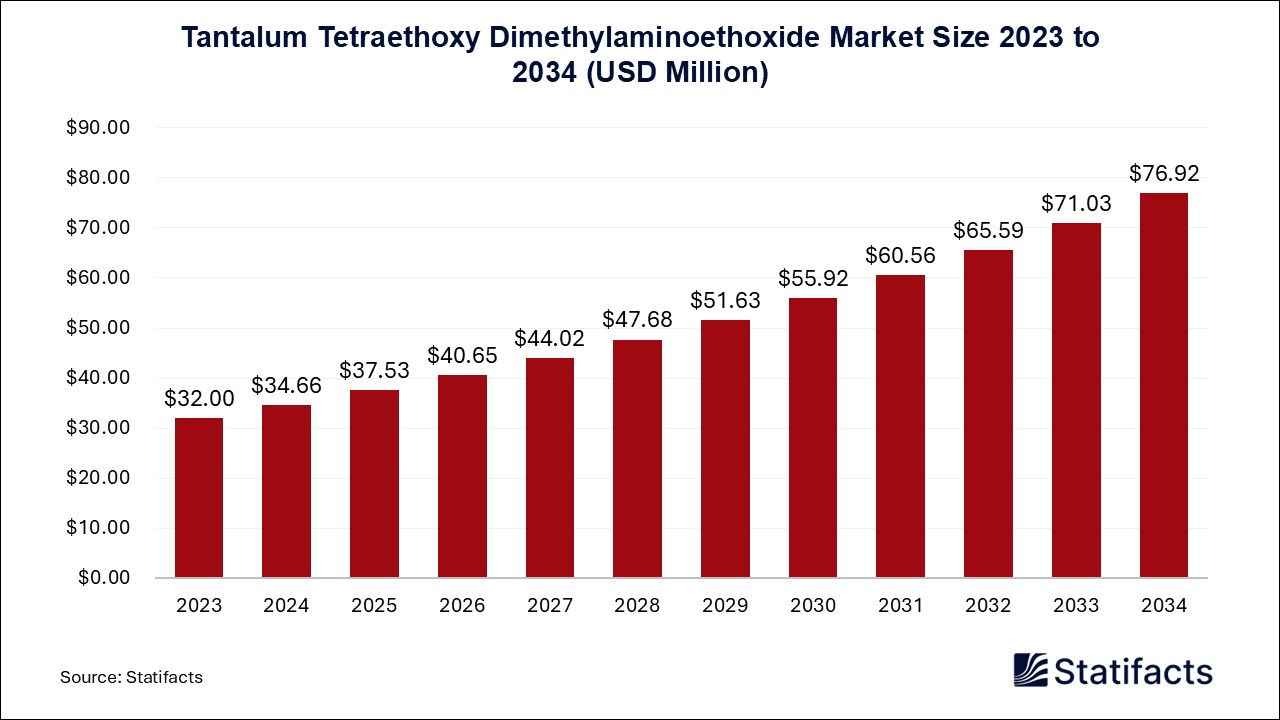Last Updated: 18 Jul 2025
Source: Statifacts
By clicking “Accept All Cookies” you agree to the storing of cookies on your device to enhance site navigation, analyze site usage, and assist in our marketing efforts.
Privacy PolicyThe global ferrous metal market size was evaluated at USD 214 billion in 2024 and is expected to grow around USD 345.70 billion by 2034, registering a CAGR of 4.91% from 2025 to 2034. The global ferrous market is witnessing robust growth due to rapid industrialization and urbanization, particularly in emerging economies like China and India. Asia Pacific leads the global ferrous metal market in both production and consumption. North America is the fastest growing market, driven by rising demand fastest-growing market, driven by rising demand for recyclable ferrous metals.
| Industry Worth | Details |
| Market Size in 2025 | USD 225.79 Billion |
| Market Size by 2034 | USD 345.7 Billion |
| Market Growth Rate from 2025 to 2034 | CAGR of 4.91% |
Ferrous metals, primarily iron and iron-based alloys such as gray iron, ductile iron, carbon steel, and stainless steel, form the backbone of global industrial development. These materials are known for their strength, durability, magnetic properties, and relatively low cost, making them indispensable across a wide array of industries. Ferrous metals are heavily utilized in the construction sector, automotive, heavy machinery, transportation, infrastructure, and even renewable energy projects. Additionally, stainless and carbon steel are widely used in consumer applications. With growing infrastructure demands, rising vehicle production, and expanding energy needs, the ferrous metal market continues to experience strong global demand. According to the World Steel Association, global crude steel production reached approximately 1,885 million tons in 2023, underscoring the scale and importance of this market.
Artificial intelligence is transforming the ferrous metal industry by optimizing production processes, improving quality control, and enhancing sustainability. Machine learning algorithms are now applied to vast datasets from furnace temperatures to raw material compositions to dynamically adjust operational parameters and reduce energy consumption in real time. Predictive maintenance systems monitor equipment like rolling mills and blast furnaces, flagging early signs of wear or failure and thus minimizing unplanned downtime. AI-powered computer vision tools inspect steel for flaws with near-perfect accuracy, reducing defects and scrap rates. Additionally, digital twins enable virtual testing of new processes and materials before physical trials, accelerating innovation and decreasing waste generation.
Infrastructure expansion, urbanization, and AI-driven efficiencies are fueling sustained growth and competitiveness in the global ferrous metal market.
The steel industry’s shift to low-carbon production faces major hurdles from high capital costs, policy uncertainty, and scrap shortages, which are challenging profitability and decarbonization goals amid the ferrous metal market.
The push for green steel is creating major opportunities through hydrogen-based ironmaking and dedicated renewable-powered hubs, poised to transform global steel supply chains into scalable, low-carbon ecosystems and transform the ferrous metal market.
“Achieving the goal of the Paris Agreement would require the decarbonization of steel value chains, presenting an opportunity for Australia and China to progress our long-term economic interests.”
Tadeu Carneiro, CEO of Boston Metal, emphasized innovation’s geopolitical impact: “If you want to eliminate coal, then you go where electricity is…you bring electricity to the iron ore mine.”
By Material, the grey iron segment dominated the market in 2024 thanks to its cost-effectiveness, high compressive strength, thermal conductivity, and excellent vibration-damping. It’s a staple material for engine blocks, pump housings, brake discs, and heavy machinery components. With Asia Pacific accounting for nearly 68% of gray iron market revenue in 2023, its dominance is fueled by China’s massive manufacturing base. Merging applications, such as wind turbine housings and EV charging infrastructure, are further improving its appeal. Continued investment in process innovation and expanding foundry capacities assures gray iron will retain its market-leading position.
By material, the stainless steel segment is anticipated to grow with the highest CAGR during the studied years, driven by surging infrastructure, automotive, energy, and industrial demand. It offers corrosion resistance, longevity, recyclability, and aesthetic appeal attributes highly prized in modern building construction and smart city projects. Rapid vehicle production, e.g, India manufactured 1.92 million vehicles in December 2024, is fueling stainless steel use in exhaust systems, fuel tanks, and structural components. The oil& gas sector’s need for durable pipeline and platform materials further supports strong uptake.
By material, the ductile iron segment is increasingly notable, capturing approximately 26% of the casting market due to its superior impact resistance and ductility. It is critical in pipeline, suspension, and wind energy applications where toughness and load-bearing capacity are essential. The automotive sector also favors ductile iron for crankshafts, cylinder heads, and heavy-duty parts.
Asia Pacific
Asia Pacific remains the clear leader in the ferrous metal market. Growth is propelled by rapid urbanization, massive infrastructure spending such as China’s Belt & Road initiative and India’s National Infrastructure pipeline, and booming automotive sectors across China, India, and Southeast Asia. The region’s competitiveness is improved by abundant raw materials, lower labor costs, supportive government policies, and rising investments in green steel technologies.
India
India stands out as the fastest-growing market, with steel demand expected to surge with the highest CAGR between 2024 and 2025. Domestic crude steel output increased by over 33% from 2019 to 2024, even and global production stagnated. This momentum is driven by sustained infrastructure projects, urban housing, and manufacturing growth under initiatives like “Make in India”. Coupled with rising electric vehicle production and a new steel plant becoming a global growth engine in ferrous metals.
The global ferrous metal industry is highly concentrated, dominated by a few mega producers with extensive operations and strong global reach, forming an oligopolistic landscape.
Baowu is the world’s largest steel producer, operating integrated mills across Asia and exporting globally. It offers flat and long steel products for automotive, construction, and infrastructure, known for investing heavily in green steel and hydrogen-based tech. Baowu leads China’s consolidation and sustainable transition efforts.
Operating in 60+ countries, ArcelorMittal produces ~69Mt of steel annually. It serves the automotive, construction, energy, and machinery sectors with flat, long wire, and plate steel products.
The world’s fourth-largest producer, Nippon Steel, serves automotive, electronics, infrastructure, and high-speed rail sectors. It offers advanced steel grades, including those for bullet trains and aerospace. Research and development are focused on carbon-neutral processes, high tensile steels, AI-powered digital transformation, and new steelmaking processes.
Published by Saurabh Bidwai
Last Updated: 18 Jul 2025
Source: Statifacts
Last Updated: 18 Jul 2025
Source: Statifacts
| Subsegment | 2024 | 2025 | 2026 | 2027 | 2028 | 2029 | 2030 | 2031 | 2032 | 2033 | 2034 |
|---|---|---|---|---|---|---|---|---|---|---|---|
| Gray Iron | 82,102.50 | 86,201.90 | 90,368.40 | 94,591.00 | 98,833.50 | 103,105.00 | 107,436.90 | 111,884.80 | 116,328.60 | 120,761.90 | 125,202.20 |
| Ductile Iron | 62,760.80 | 66,501.00 | 70,376.50 | 74,384.10 | 78,497.40 | 82,732.30 | 87,115.60 | 91,700.00 | 96,392.40 | 101,198.40 | 105,928.60 |
| Carbon Steel | 32,441.60 | 34,292.90 | 36,206.00 | 38,178.80 | 40,202.10 | 42,278.90 | 44,425.60 | 46,672.60 | 48,965.00 | 51,306.30 | 53,614.90 |
| Stainless Steel | 20,399.40 | 21,843.90 | 23,357.10 | 24,939.10 | 26,584.30 | 28,296.80 | 30,091.80 | 31,982.20 | 33,951.90 | 35,991.40 | 37,984.30 |
| Others (Malleable Iron, etc.) | 16,293.80 | 16,950.70 | 17,612.10 | 18,276.20 | 18,937.20 | 19,597.30 | 20,263.30 | 20,942.80 | 21,622.20 | 22,295.80 | 22,973.20 |
Last Updated: 18 Jul 2025
Source: Statifacts
| Subsegment | 2024 | 2025 | 2026 | 2027 | 2028 | 2029 | 2030 | 2031 | 2032 | 2033 | 2034 |
|---|---|---|---|---|---|---|---|---|---|---|---|
| Gray Iron | 82,102.50 | 86,201.90 | 90,368.40 | 94591 | 98,833.50 | 103105 | 107,436.90 | 111,884.80 | 116,328.60 | 120,761.90 | 125,202.20 |
| Ductile Iron | 62,760.80 | 66501 | 70,376.50 | 74,384.10 | 78,497.40 | 82,732.30 | 87,115.60 | 91700 | 96,392.40 | 101,198.40 | 105,928.60 |
| Carbon Steel | 32,441.60 | 34,292.90 | 36206 | 38,178.80 | 40,202.10 | 42,278.90 | 44,425.60 | 46,672.60 | 48965 | 51,306.30 | 53,614.90 |
| Stainless Steel | 20,399.40 | 21,843.90 | 23,357.10 | 24,939.10 | 26,584.30 | 28,296.80 | 30,091.80 | 31,982.20 | 33,951.90 | 35,991.40 | 37,984.30 |
| Others (Malleable Iron, etc.) | 16,293.80 | 16,950.70 | 17,612.10 | 18,276.20 | 18,937.20 | 19,597.30 | 20,263.30 | 20,942.80 | 21,622.20 | 22,295.80 | 22,973.20 |
Market growth is fueled by booming infrastructure development, rising demand from the automotive and construction sectors, and increasing adoption of recycled steel to support sustainability and circular economy goals.
Construction and infrastructure remain the dominant applications, accounting for the majority of demand through reinforced steel, castings, and structural components used in roads, bridges, and public utilities.
The automotive sector is experiencing the fastest growth, driven by demand for high-strength steel in vehicles, as well as rising production of light-duty and electric vehicles.
Sustainability initiatives, such as recycling and the use of electric arc furnaces, combined with automation, AI-driven foundry processes, and green manufacturing practices, are key market trends.
Challenges include market volatility from tariffs on imported steel, consolidation of major producers, supply chain pressures, and compliance with environmental and trade regulations.
To get full access to our Market Insights, you need a Professional Account or a Business Suite.

You will receive an email from our Business Development Manager. Please be sure to check your SPAM/JUNK folder too.

You will receive an email from our Business Development Manager. Please be sure to check your SPAM/JUNK folder too.

Our customers work more efficiently and benefit from


